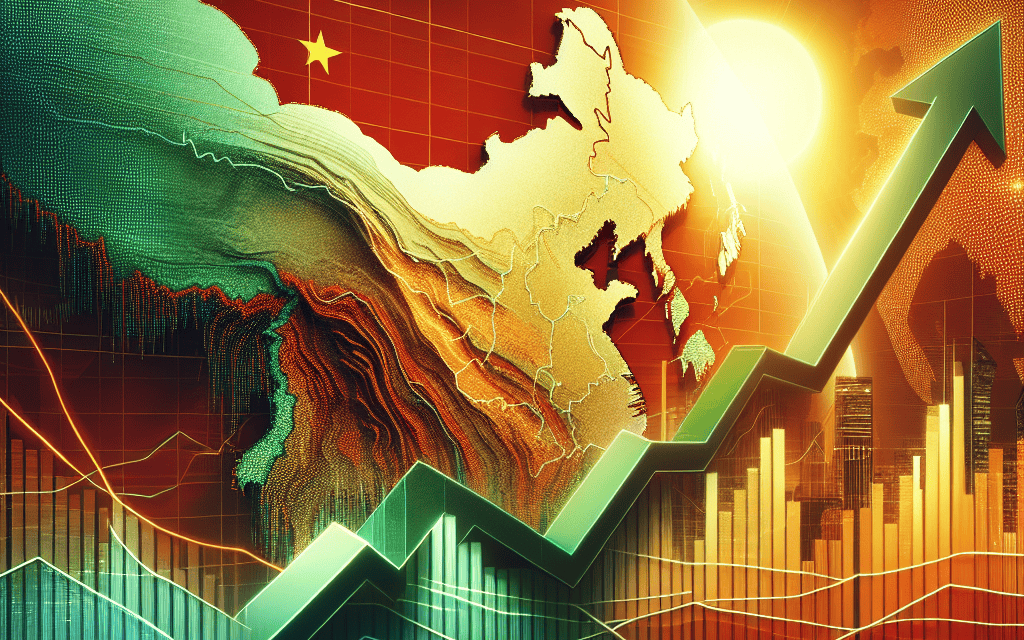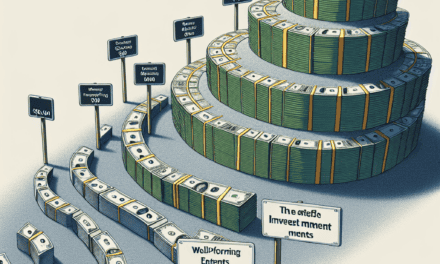“Daily Spotlight: Can China’s Momentum Sustain the Surge?”
Introduction
“Daily Spotlight: Can China Rally Last?” delves into the recent surge in China’s financial markets, exploring the factors driving this momentum and assessing its sustainability. As global investors turn their attention to China’s economic policies, market reforms, and geopolitical influences, this analysis provides a comprehensive overview of the current rally. It examines the underlying economic indicators, potential risks, and the broader implications for international markets. By evaluating expert opinions and historical trends, the piece aims to offer insights into whether this rally is a fleeting phenomenon or a sign of long-term growth potential in the world’s second-largest economy.
Analyzing China’s Economic Indicators: A Closer Look at the Rally’s Sustainability
In recent months, China’s economic landscape has been under intense scrutiny as analysts and investors alike ponder the sustainability of its current rally. The world’s second-largest economy has shown signs of recovery, but questions remain about whether this momentum can be maintained. To understand the potential longevity of this rally, it is essential to delve into the various economic indicators that provide insight into China’s economic health.
One of the primary indicators to consider is China’s Gross Domestic Product (GDP) growth rate. After a period of deceleration, recent data suggests a rebound, with GDP growth showing signs of stabilization. This resurgence can be attributed to several factors, including government stimulus measures and a rebound in consumer spending. However, while these figures are promising, it is crucial to recognize that they are not without their caveats. The sustainability of GDP growth is contingent upon continued domestic demand and the ability to navigate external challenges, such as trade tensions and global economic uncertainties.
In addition to GDP, industrial production is another critical metric that sheds light on China’s economic trajectory. Recent reports indicate an uptick in industrial output, driven by increased manufacturing activity and infrastructure investments. This growth in industrial production is a positive sign, suggesting that China’s manufacturing sector is regaining its footing. Nevertheless, it is important to consider the potential impact of supply chain disruptions and fluctuating global demand, which could pose risks to sustained industrial growth.
Moreover, the health of China’s export sector is a vital component of its economic rally. Exports have shown resilience, with a notable increase in shipments to key trading partners. This uptick is partly due to the global recovery from the pandemic, which has spurred demand for Chinese goods. However, the export sector’s future performance is closely tied to geopolitical dynamics and the stability of international trade relations. Any escalation in trade disputes or protectionist measures could hinder export growth and, by extension, the broader economic rally.
Another factor to consider is the role of consumer confidence in driving economic activity. Recent surveys indicate a rise in consumer sentiment, which bodes well for domestic consumption. This increase in confidence is reflected in higher retail sales figures, suggesting that Chinese consumers are more willing to spend. However, sustaining this trend will require addressing underlying issues such as income inequality and ensuring that wage growth keeps pace with inflation.
Furthermore, the real estate sector, a significant contributor to China’s economy, warrants attention. While property sales have shown signs of recovery, the sector remains vulnerable to regulatory changes and potential market corrections. The government’s efforts to curb speculative investments and ensure affordable housing could impact the sector’s growth trajectory. Balancing these regulatory measures with the need to maintain economic momentum will be a delicate task for policymakers.
In conclusion, while China’s economic rally appears promising, its sustainability hinges on a complex interplay of domestic and international factors. The resilience of GDP growth, industrial production, exports, consumer confidence, and the real estate sector will all play pivotal roles in determining the rally’s longevity. As such, stakeholders must remain vigilant and adaptable to the evolving economic landscape, recognizing that the path to sustained growth is fraught with challenges and uncertainties. By closely monitoring these economic indicators, investors and policymakers can better navigate the complexities of China’s economic future.
The Role of Government Policies in China’s Market Rally
In recent months, China’s financial markets have experienced a notable rally, capturing the attention of global investors and analysts alike. This surge in market activity can be largely attributed to a series of government policies aimed at stimulating economic growth and stabilizing the financial landscape. As we delve into the intricacies of these policies, it becomes evident that the Chinese government’s strategic interventions have played a pivotal role in shaping the current market dynamics.
To begin with, the Chinese government has implemented a range of fiscal and monetary measures designed to bolster economic activity. These include tax cuts, increased infrastructure spending, and targeted financial support for key industries. By reducing the tax burden on businesses and individuals, the government aims to increase disposable income and encourage consumer spending, thereby driving economic growth. Simultaneously, infrastructure investments are intended to create jobs and improve the country’s long-term economic prospects. These fiscal policies, in conjunction with accommodative monetary measures such as interest rate cuts and liquidity injections, have provided a much-needed boost to the market.
Moreover, regulatory reforms have also played a crucial role in the market rally. The Chinese government has undertaken significant steps to enhance the transparency and efficiency of its financial markets. For instance, efforts to streamline the approval process for initial public offerings (IPOs) and reduce bureaucratic red tape have made it easier for companies to access capital markets. Additionally, the introduction of new regulations aimed at curbing excessive speculation and ensuring market stability has helped restore investor confidence. These regulatory changes have not only attracted domestic investors but have also piqued the interest of foreign investors seeking to capitalize on China’s growth potential.
In addition to fiscal and regulatory measures, the Chinese government has also focused on fostering innovation and technological advancement. Recognizing the importance of technology in driving future economic growth, the government has prioritized investments in research and development, particularly in sectors such as artificial intelligence, renewable energy, and biotechnology. By supporting innovation, the government aims to transition the economy from a reliance on traditional manufacturing to a more sustainable, knowledge-based model. This strategic shift has been well-received by investors, who view it as a positive indicator of China’s long-term growth prospects.
Furthermore, the government’s commitment to international trade and investment has also contributed to the market rally. Despite ongoing geopolitical tensions, China has continued to pursue trade agreements and strengthen economic ties with other countries. Initiatives such as the Belt and Road Initiative have not only expanded China’s global influence but have also opened up new markets for Chinese companies. By fostering a favorable trade environment, the government has provided additional growth opportunities for domestic businesses, further fueling the market rally.
However, it is important to note that while government policies have been instrumental in driving the current market rally, challenges remain. Issues such as rising debt levels, demographic shifts, and environmental concerns pose potential risks to China’s long-term economic stability. As such, the sustainability of the market rally will depend on the government’s ability to address these challenges while maintaining a balanced approach to economic growth.
In conclusion, the recent rally in China’s financial markets can be largely attributed to a combination of government policies aimed at stimulating economic growth, enhancing market efficiency, and fostering innovation. While these measures have undoubtedly played a significant role in shaping the current market dynamics, the future trajectory of China’s markets will depend on the government’s ability to navigate the complex challenges that lie ahead. As investors continue to monitor developments in China, the role of government policies will remain a key factor in determining the sustainability of the market rally.
Global Implications of China’s Economic Resurgence
China’s economic resurgence has captured global attention, raising questions about the sustainability of its growth and the broader implications for the world economy. As the world’s second-largest economy, China’s performance is pivotal not only for its domestic prosperity but also for global economic stability. The recent rally in China’s economic indicators, including industrial production, retail sales, and export figures, suggests a robust recovery from the pandemic-induced slowdown. However, the question remains: can this rally last, and what does it mean for the global economic landscape?
To understand the potential longevity of China’s economic rally, it is essential to consider the factors driving this resurgence. A significant contributor has been the Chinese government’s strategic policy interventions, which have included fiscal stimulus measures and monetary easing. These policies have been instrumental in boosting domestic demand and supporting key industries. Moreover, China’s adept handling of the COVID-19 pandemic, characterized by swift lockdowns and mass vaccination campaigns, has facilitated a quicker return to normalcy compared to many other nations. This has allowed China to capitalize on the global demand for goods, particularly in sectors like electronics and medical supplies, where it holds a competitive advantage.
Nevertheless, while these factors have spurred short-term growth, there are underlying challenges that could impede the sustainability of China’s economic rally. One such challenge is the mounting debt levels, both at the corporate and local government levels. The reliance on debt-fueled growth raises concerns about financial stability, as excessive borrowing could lead to defaults and a potential banking crisis. Additionally, China’s real estate sector, a significant driver of economic activity, faces its own set of issues, including over-leveraging and regulatory crackdowns aimed at curbing speculative investments. These factors could dampen investor confidence and slow down economic momentum.
Furthermore, the global implications of China’s economic resurgence are multifaceted. On one hand, a strong Chinese economy can act as a catalyst for global growth, providing a market for exports from other countries and contributing to the stability of global supply chains. This is particularly relevant for emerging markets that rely heavily on Chinese demand for their commodities and manufactured goods. On the other hand, China’s economic policies and practices, such as its approach to trade and technology, continue to be a source of tension with major economies like the United States and the European Union. These geopolitical frictions could lead to trade disputes and impact global economic cooperation.
In addition, China’s focus on transitioning to a more sustainable and innovation-driven economy presents both opportunities and challenges for the global community. As China invests in green technologies and digital infrastructure, it could set new standards and drive global advancements in these fields. However, this transition also requires significant structural changes within China, which could lead to short-term disruptions and affect global markets.
In conclusion, while China’s economic rally presents a promising outlook, its sustainability is contingent upon addressing domestic challenges and navigating complex global dynamics. The world will be closely watching China’s next moves, as its economic trajectory will undoubtedly have far-reaching implications. As such, policymakers and businesses worldwide must remain vigilant and adaptable to the evolving landscape, ensuring that they are well-positioned to respond to both the opportunities and challenges that arise from China’s economic resurgence.
Investor Sentiment: How Confidence is Shaping China’s Market Trends

Investor sentiment plays a pivotal role in shaping market trends, and this is particularly evident in the context of China’s financial markets. As the world’s second-largest economy, China has been a focal point for global investors, who are keenly observing whether the recent rally in Chinese markets can be sustained. The question of whether this rally can last is intricately tied to the confidence levels of both domestic and international investors, which are influenced by a myriad of factors ranging from economic policies to geopolitical developments.
To begin with, the Chinese government’s economic policies have a significant impact on investor sentiment. In recent years, China has implemented a series of reforms aimed at stabilizing its economy and promoting sustainable growth. These measures include efforts to deleverage the financial sector, enhance regulatory oversight, and encourage innovation. Such policies are designed to instill confidence among investors by demonstrating a commitment to long-term economic stability. However, the effectiveness of these policies in boosting investor confidence is contingent upon their successful implementation and the ability to address underlying economic challenges.
Moreover, the global economic environment also plays a crucial role in shaping investor sentiment towards China. As the world grapples with uncertainties such as trade tensions, fluctuating commodity prices, and the lingering effects of the COVID-19 pandemic, investors are closely monitoring how these factors impact China’s economic prospects. A stable global economic environment can bolster confidence in China’s markets, while heightened uncertainties may lead to increased volatility and risk aversion among investors.
In addition to economic policies and global factors, geopolitical developments are another critical determinant of investor sentiment. China’s relationships with major economies, particularly the United States, have a profound influence on market trends. Trade negotiations, diplomatic engagements, and strategic partnerships all contribute to shaping the perception of China’s economic future. Positive developments in these areas can enhance investor confidence, while tensions or conflicts may lead to caution and hesitancy.
Furthermore, the role of domestic investors cannot be overlooked when assessing the sustainability of China’s market rally. Domestic investors, including retail and institutional participants, are often driven by factors such as consumer confidence, income growth, and access to investment opportunities. The Chinese government’s efforts to promote financial literacy and expand access to capital markets have the potential to empower domestic investors and sustain market momentum. However, any signs of economic slowdown or policy missteps could dampen domestic investor enthusiasm and impact market trends.
In conclusion, the sustainability of China’s market rally is intricately linked to investor sentiment, which is shaped by a complex interplay of economic policies, global economic conditions, geopolitical developments, and domestic factors. While there are reasons for optimism, such as China’s commitment to economic reforms and its strategic global partnerships, challenges remain that could influence investor confidence. As investors continue to navigate this dynamic landscape, their perceptions and actions will play a crucial role in determining whether the rally can be sustained. Ultimately, the ability of China’s markets to maintain their upward trajectory will depend on a delicate balance of these factors, underscoring the importance of monitoring investor sentiment as a key indicator of future market trends.
Sector Spotlight: Industries Driving China’s Economic Rally
China’s economic landscape has long been a focal point for global investors, and recent developments have reignited interest in the potential for a sustained rally. As the world’s second-largest economy, China’s growth trajectory significantly influences global markets. The question on many minds is whether the current rally can be sustained, and to answer this, one must delve into the industries driving this economic resurgence.
To begin with, the technology sector stands at the forefront of China’s economic rally. With the government’s strategic focus on innovation and digital transformation, tech companies have experienced substantial growth. The push towards 5G technology and artificial intelligence has not only spurred domestic advancements but also positioned China as a formidable player on the global stage. Companies in this sector are benefiting from increased investments and favorable policies, which are likely to continue driving growth in the foreseeable future.
In addition to technology, the renewable energy sector is playing a pivotal role in China’s economic rally. As the world grapples with climate change, China has committed to reducing its carbon footprint, leading to a surge in investments in solar, wind, and other renewable energy sources. This commitment is not only environmentally significant but also economically strategic, as it reduces reliance on imported fossil fuels and fosters energy independence. The growth in this sector is supported by both government initiatives and private sector innovation, creating a robust foundation for sustained economic expansion.
Moreover, the consumer goods industry is witnessing a resurgence, fueled by a growing middle class with increasing purchasing power. As disposable incomes rise, there is a marked shift in consumer behavior, with a preference for premium products and services. This trend is particularly evident in the e-commerce space, where companies are capitalizing on digital platforms to reach a broader audience. The integration of technology in retail has revolutionized the shopping experience, further driving growth in this sector.
Transitioning to the financial sector, China’s banking and financial services are undergoing significant reforms aimed at increasing transparency and efficiency. These reforms are designed to attract foreign investment and integrate China’s financial markets with the global economy. The liberalization of financial services, coupled with the development of new financial products, is expected to bolster economic growth and provide a stable environment for the rally to continue.
However, it is essential to consider the challenges that could impede this rally. Geopolitical tensions, particularly with major trading partners, pose a risk to China’s economic stability. Additionally, the real estate sector, which has been a significant growth driver in the past, faces potential headwinds due to regulatory tightening and concerns over debt levels. These factors could create volatility and impact investor confidence.
In conclusion, while several industries are propelling China’s economic rally, the sustainability of this growth depends on navigating both domestic and international challenges. The technology, renewable energy, consumer goods, and financial sectors are poised to continue their upward trajectory, provided that supportive policies and global economic conditions remain favorable. As China continues to evolve and adapt to changing circumstances, the potential for a sustained rally remains, albeit with cautious optimism. Investors and policymakers alike will need to remain vigilant and responsive to the dynamic economic landscape to ensure that the rally can indeed last.
Comparing China’s Rally with Other Emerging Markets
In recent months, China’s financial markets have experienced a notable rally, capturing the attention of global investors and analysts alike. This surge in market activity has prompted comparisons with other emerging markets, raising questions about the sustainability and implications of China’s economic resurgence. To understand the dynamics at play, it is essential to examine the factors driving China’s rally and how they compare to those influencing other emerging economies.
China’s rally can be attributed to several key factors, including government policy interventions, economic reforms, and a rebound in consumer confidence. The Chinese government has implemented a series of measures aimed at stabilizing the economy, such as reducing interest rates and increasing fiscal spending. These actions have bolstered investor confidence, leading to increased capital inflows and a subsequent rise in stock prices. Additionally, China’s commitment to structural reforms, such as opening up its financial markets to foreign investors, has further enhanced its appeal as an investment destination.
In contrast, other emerging markets have faced a more mixed set of circumstances. While some countries have benefited from similar policy interventions, others have struggled with political instability, currency fluctuations, and external economic pressures. For instance, Brazil and India have also seen positive market movements, driven by domestic reforms and favorable global conditions. However, these countries continue to grapple with challenges such as inflationary pressures and geopolitical tensions, which can undermine investor confidence.
Moreover, the global economic landscape plays a crucial role in shaping the performance of emerging markets. The ongoing recovery from the COVID-19 pandemic has led to increased demand for commodities, benefiting resource-rich countries like Russia and South Africa. However, the potential for rising interest rates in developed economies poses a risk to emerging markets, as it could lead to capital outflows and increased borrowing costs. In this context, China’s ability to maintain its rally will depend on its capacity to navigate these external challenges while continuing to implement effective domestic policies.
Another factor to consider is the role of technology and innovation in driving economic growth. China has made significant strides in this area, with its tech sector playing a pivotal role in the country’s economic resurgence. The rapid development of digital infrastructure and the proliferation of e-commerce platforms have contributed to increased productivity and consumer spending. In comparison, other emerging markets are at varying stages of technological advancement, with some countries lagging behind in terms of digital adoption and innovation.
Furthermore, the geopolitical landscape adds another layer of complexity to the analysis. China’s growing influence on the global stage has led to increased scrutiny and tensions with other major economies, particularly the United States. These geopolitical dynamics can have far-reaching implications for China’s economic prospects and its ability to sustain its market rally. In contrast, other emerging markets may benefit from a more neutral geopolitical stance, allowing them to attract investment without the same level of external pressures.
In conclusion, while China’s rally has been impressive, its sustainability remains uncertain in the face of both domestic and global challenges. Comparing China’s performance with other emerging markets highlights the diverse factors influencing economic growth and market dynamics. As investors continue to assess the potential risks and rewards, the ability of emerging markets to adapt to changing conditions will be crucial in determining their long-term success. Ultimately, the interplay between domestic policies, global economic trends, and geopolitical considerations will shape the future trajectory of China’s rally and its standing among emerging markets.
Risks and Challenges: What Could Derail China’s Economic Momentum?
China’s economic momentum has been a focal point of global attention, with many analysts and investors closely monitoring its trajectory. The recent rally in China’s economy has sparked optimism, yet it is crucial to consider the risks and challenges that could potentially derail this momentum. Understanding these factors is essential for stakeholders who are keen on navigating the complexities of China’s economic landscape.
One of the primary risks facing China’s economic rally is the potential for policy missteps. The Chinese government has been actively implementing measures to stimulate growth, including fiscal policies and monetary easing. However, the delicate balance between stimulating the economy and maintaining financial stability is a challenging task. Overzealous stimulus measures could lead to overheating, while insufficient intervention might result in stagnation. Therefore, the precision of policy implementation is critical in sustaining economic momentum.
In addition to domestic policy challenges, China’s economic rally is also vulnerable to external factors. The global economic environment remains uncertain, with geopolitical tensions and trade disputes posing significant threats. For instance, the ongoing trade tensions between China and the United States have the potential to disrupt supply chains and affect trade flows. Such disruptions could have a cascading effect on China’s export-driven economy, thereby hindering its growth prospects.
Moreover, China’s reliance on real estate as a key driver of economic growth presents another challenge. The real estate sector has been a significant contributor to China’s GDP, but it also poses risks due to its speculative nature. A potential real estate bubble could lead to a sharp correction, impacting not only the property market but also the broader economy. The Chinese government has been attempting to curb excessive speculation in the real estate sector, yet the effectiveness of these measures remains to be seen.
Furthermore, China’s demographic trends could also pose long-term challenges to its economic momentum. The country is experiencing an aging population, which could lead to a shrinking workforce and increased pressure on social welfare systems. This demographic shift may result in slower economic growth unless countered by productivity gains or policy adjustments. The government’s efforts to address these demographic challenges, such as relaxing the one-child policy, are steps in the right direction, but their impact will take time to materialize.
Environmental concerns also loom large as potential disruptors of China’s economic rally. The country’s rapid industrialization has led to significant environmental degradation, which could have long-term implications for sustainable growth. The Chinese government has recognized the importance of addressing environmental issues and has been investing in green technologies and renewable energy. However, the transition to a more sustainable economic model is fraught with challenges and requires substantial investment and commitment.
In conclusion, while China’s economic rally has generated optimism, it is not without its risks and challenges. Policy missteps, external geopolitical tensions, reliance on the real estate sector, demographic shifts, and environmental concerns all pose potential threats to sustained economic growth. Stakeholders must remain vigilant and adaptable, recognizing that the path to continued economic momentum is complex and multifaceted. By addressing these challenges proactively, China can enhance its prospects for long-term economic stability and growth.
Q&A
1. **What is the Daily Spotlight about?**
The Daily Spotlight focuses on the potential sustainability of a rally in China’s financial markets.
2. **What factors are influencing the Chinese market rally?**
Factors include government policy support, economic data releases, and investor sentiment.
3. **What role does government policy play in the rally?**
Government policy, such as fiscal stimulus and regulatory changes, can significantly impact market performance and investor confidence.
4. **How does economic data affect the rally?**
Positive economic data can boost investor confidence and drive market gains, while negative data can have the opposite effect.
5. **What are the risks to the sustainability of the rally?**
Risks include geopolitical tensions, potential policy missteps, and global economic uncertainties.
6. **How are investors reacting to the rally?**
Investors may be cautiously optimistic, balancing potential gains with the risks involved.
7. **What is the outlook for the Chinese market rally?**
The outlook is uncertain, with potential for both continued growth and setbacks depending on various economic and geopolitical factors.
Conclusion
The conclusion about the Daily Spotlight: Can China Rally Last? is that while China’s economic rally shows promising signs of recovery and growth, several factors could influence its sustainability. These include the government’s policy measures, global economic conditions, and domestic challenges such as debt levels and demographic shifts. Investors should remain cautious and consider these variables when assessing the longevity of China’s economic resurgence.





